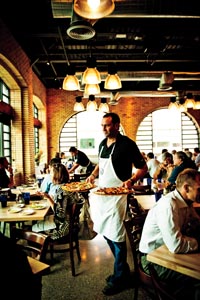
Why, someone might ask, would we want to write about a place that doesn’t offer more than a handful of small pizzas, half a dozen salads, and an assortment of appetizer-tray meats and cheeses? After all, there are hundreds of these around metro Detroit.
The answer: Because it’s the newest venture by Luciano del Signore, the chef-owner of Bacco Ristorante — our very own Mario Batali.
Pizzeria Biga is del Signore’s foray into less-expensive dining, and it’s terrific. There’s no other way to say it. Like just the right pinch of salt on a dish, everything del Signore does with food seems to come out with perfect flavor, balance, and texture. Biga is no exception.
Call it “Molto” Luciano.
Biga is energetic, lively, bright, and very modern with the urban feel of a somewhat-rowdy lunch spot that you might find in Milan, the land of slow food.
Biga tackles the lower end of the dining scale by taking the basic idea of pizza as inexpensive dining and moving it to a higher level: better dough, fresher and better quality ingredients — oh, the exceptional fresh bufala mozzarella they use — and an almost butterfly-lightness of touch in the preparation and cooking.
When word filtered out some months ago that the owner of Bacco was picking up the spot left empty more than a year ago by the departure of Il Posto (his longtime friendly rival down the street on Northwestern Highway) and planned to make it into a pizzeria, a lot of people wondered what it would look like.
Gone are Il Posto’s massive velvet drapes, soft lighting, tiered dining room, and plush red banquettes, none of which lend themselves to a pizza joint. The place was gutted and refitted, expanded, and use of the space reversed. There’s nothing recognizable, other than three brick interior arches. The sides of arched-window glass has been removed and panels of slatted frosted glass have been added to give Biga an almost Asian touch.
As you enter the dining room, Biga’s roaring wood ovens are in plain view behind a counter fronted by bright-blue stools. A gaggle of kitchen staff in chef whites scurry here and there preparing food as wait staff in black T-shirts and white aprons rush pizzas and salads to tables.
Also gone is the intimate table lighting of the old restaurant. That has been replaced by banks of large glass-shaded halogen bulbs overhead. Shiny new stainless air-vent pipes snake — loft-style — across the open ceiling.
Bright-blue water glasses, stuffed pocket-hanky style with white cloth napkins — dominate the four-person butcher-block tables. The wood chairs are simple ladder-back style. The former carpeted floors are now tiled, which increases the decibel level to a just-right volume for this kind of place.
Take-out and market-style shopping is a centerpiece of Biga, which is also family friendly for those choosing to eat in the dining room.
Del Signore, who resembles a tall version of Al Pacino, commutes between the two restaurants, which are about a quarter-mile apart, on a Segway.
Biga’s menu is, indeed, almost startlingly brief: six salads, nine little dishes for appetizers, six “white” pizzas (without sauce but with toppings and cheese), and six more “red” pies with other ingredients and a delicate tomato sauce on the dough that leaves about as much color as a hint of lipstick on a cheek.
The prices of individual dishes — choices of starters, salads, and individual pizzas — range from $4 to $14.
Price and simplicity aside, it’s the brightness of flavor, freshness, and quality that mark the food at Biga. Most of the cold meats — salami, speck, prosciutto, bresaola, duck prosciutto, and others — are made right at Bacco’s kitchen, as is the sausage used on the pizzas.
The pies include such old standards as the Margherita, with the freshest, lightest bufala mozzarella I’ve had in a long time. You may also build your own pizza with fresh mushrooms, Biga’s meats, or Italian tuna and other ingredients.
Recommended is a first-course small plate of rice balls, in the middle of which are Bolognese sauce with peas and mozzarella surrounded by saffron rice, which is fried golden and served on a light tomato sauce — for a mere $6.
A chopped salad, made of hearts of palm, iceberg lettuce, artichoke, egg, tomato, cucumber, onion, Gorgonzola, and garbanzo beans is finished with a zesty, citrusy oil dressing.
Another inventive salad is composed of navel-orange slices with olives, onion, and parsley with a light dressing. There’s also the zippy artichokes braised in white wine and finished with olive oil, lemon, and parsley. And for an adventure in delicacy, try the zucchini-squash blossoms stuffed with ricotta, lemon, and basil. Lovely.
What is also startlingly good at Pizzeria Biga is the wine list. Nearly 100 reds, whites, and rosés are listed, mostly at $20 to $40 — all unusual and good value with many gems. You could say that the quality and depth of the wine exceeds the menu, but even at that, the wines have been very carefully chosen to not be budget busters.
For example, my guest at Biga, a well-known and respected California wine writer, was surprised to find a Correggia Roero Nebbiolo from Piedmonte on the list, a wine not all that commonly available. Most of the wines are red; many are Montepulciano d’Abruzzo, Tuscans, and a range of southern Italian reds from Puglia and Calabria.
Pizzeria Biga is not the first eatery to trend toward the more-casual, less-expensive model of dining. The metro area has been perked up in these recessionary times by several of these restaurants. But this one is hands-down one of the best to come along. What a welcome pleasure!
29110 Franklin Rd., Southfield; 248-750-2442. L & D daily.
|
|
|









